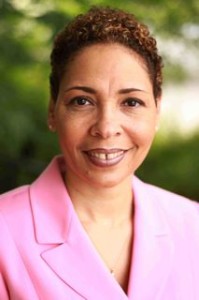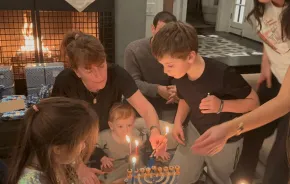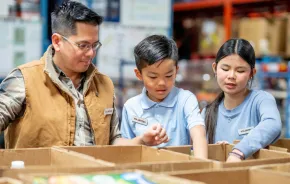
Brace yourself: Seattle has the fifth-biggest achievement gap between black and white students among the country’s 200 biggest school districts, according to a new Stanford University study. When compared with their white peers in Seattle, black students lag by three and a half grade levels, says the Seattle Times article where I first learned of the study.
Shortly after, I read about a 66-year-old black woman who’s selling her Redmond shop because she doesn’t feel comfortable after a white customer reportedly left behind a bag containing a Ku Klux Klan robe.
It’s hard enough to wrap my own head around these stories, let alone discuss them with my young daughters. So when one night during dinner, my teen expressed shock that a friend from Africa has been told he should “go back home,” I struggled. This was a teachable moment, a time to talk about racism but how to approach a problem so huge?
Addressing that question is the inspiration behind much of Caprice Hollins’ work. The Seattle local, mother and clinical psychologist previously served as the director of equity, race and learning support for Seattle Public Schools. Despite modest success, including a slightly narrowed racial gap in standardized test scores, Hollins’ four-year tenure was controversial. Critics felt her methods overreached and in 2008, the district eliminated her department.
It’s since been reinstated and, the Seattle Times reports, Hollins was recently invited back to conduct workshops. Such outreach is the focus of her organization, Cultures Connecting, which provides professional consulting and coaching to facilitate conversations about race, culture and social justice.
Here’s what Hollins recommended when talking about racism with our children.
Tell me about yourself and your work.
I’m multiracial; my mom is white and I have four older white siblings and a younger sister who is also multiracial. One of my brothers is gay … [Despite this background,] the first time I ever explored dynamics of difference in a formal way was in graduate school in California. That pretty much changed my world.
Parents of color tend to talk to their children of color about racism; how to act when you go to the store or get pulled over by the police, for example. Yet research shows that white parents tend not to talk about race. My mother didn’t talk with me about racism and so I wasn’t prepared when I began to experience it. I don’t think she knew how. I think she thought that if she loved me well, it would be enough to help me deal with it.
When I left graduate school, I felt a deep desire to do this work to help people better understand and address what’s going on in our country as it relates to racism and race relations. The moments or places that are real that white parents get stuck when talking about racism, parents of color get stuck there too.
As a white parent, I’m so worried I’ll say the wrong thing about race that I find myself avoiding the topic or skirting around the edges. Why do you think it’s so hard for white people to talk about race?
When children are young and they notice difference, they point it out. Often they are 2 or 3 and they are told it’s not O.K. to ask questions about difference.
When their parents shush them, they learn not only can they not talk about differences, but there must be something wrong with people who are different. So often we want to talk about similarities with the idea that talking about differences divides us. But not talking about differences is what really divides us.
What’s the easiest way that we can start talking about race with young children?
Choose books with multicultural content to read to your children. Talk about difference in a positive way instead of talking about difference as if there is something bad about being different. Take children to different multicultural events. Help them to really see difference as positive instead of something that we ignore. Teachers can look closely at their curriculum. Who are the speakers they invite to talk to their students? What videos do you use for teaching? Expose your kids to diversity beyond what they get exposed to in media.
How do we change the conversation about cultural and racial stereotypes?
We create counter-narratives. Whatever the stereotype is, you create counter-messages that expose your children to a new way of thinking ... If the cultural message is girls aren’t good at math, the message becomes ‘Wow! Look how well you did on that math problem. You can figure it out.’
The messages in our society are that black and brown skin aren't thought of as beautiful. [To counter this] say to your son or daughter, ‘Look how beautiful your dark skin is.’
Our reflex is to jump in with a lecture and say, 'That’s racist.' Instead, teachable moments are the time for questions.
I always introduce myself to children as Dr. Hollins. My name is a counter-narrative for white children and children of color. It shows them that there are people of different ethnicities and races who are doctors.
When I call for appointments for my children, I ask if there is a dentist of doctor of color so they will be exposed to people of color who are in positions of power and influence. I’m intentional about making sure they see people that look like them and people of color in general in these different professions.
The other night at dinner my teen told me she was shocked to learn that people had told her African friend to go back where he came from. I knew this was a teachable moment, but I wasn’t quite sure what to do. What do you recommend for moments like this one?
All of us as parents are faced with teachable moments. It can be as simple as noticing a Muslim person praying on the sidewalk while you are out walking, talking about same gender families in your community or seeing a woman in a sari driving in the car next to yours. Lightly discussing these topics are a way to normalize difference. When you notice difference with your children, ask them if they understand why someone is dressed a particular way or if they know what that person is doing. For older children, you can do research together on the web.
For those moments as a parent when your head starts spinning and you know you are in the middle of a bigger teachable moment, go to questions before education. When your daughter says her friend was told to go back to Africa, explore your daughter’s worldview by asking her questions with genuine curiosity. When your daughter says she can’t believe someone said that to her friend, ask her what makes it hard for her to believe that. Find out what she learned about her friend’s experience. How did it make her friend feel? How did it make your daughter feel hearing about her friend’s experience? Take this as an opportunity to teach her about racism beyond her friend’s experience.
Our reflex is to jump in with a lecture and say, 'That’s racist.' Instead, teachable moments are the time for questions … We’re practicing having conversation rather than going quickly to educating kids.
READ MORE: Racism: Families Push for Racial Justice
 With my kids, I try not to go into shaming or blaming them when they stereotype. I remind myself that they are saying aloud the things that they’ve learned. I want them to critically explore their thinking.
With my kids, I try not to go into shaming or blaming them when they stereotype. I remind myself that they are saying aloud the things that they’ve learned. I want them to critically explore their thinking.
How do we get them thinking critically about this thing they are surprised around? Shaming or blaming into understanding or educating them will shut the conversation down. And you want to keep the conversation going.
After the teachable moment has passed, how do we reengage around that topic?
There’s a clinical term for that. We call it ‘circling back around.’ Reengage your daughter on the conversation by saying, ‘I’ve been thinking about our conversation. Say, ‘I never asked you why it was difficult for you to believe [that situation occurred].’
The question is how to get to that place where she can voice what it feels like for her to hear these comments. When she can experience how she feels about racism, she can begin to engage her friend around the topic. Then she might be able to ask her friend how he feels about these racist comments. Who knows? It might even turn her into an ally.











